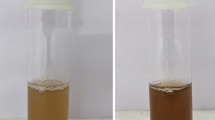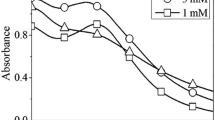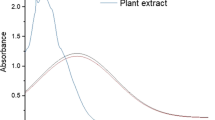Abstract
Recent surges in fabrication of nanoparticles (NPs) have motivated researchers to find an eco-friendly method to reduce metal precursors into nanoparticles. In this work, Combretum indicum leaf extract was used to synthesize silver nanoparticles (CI-AgNPs) because it is a readily accessible, affordable, sustainable resource and less exploited for the synthesis of nanoparticles. Physicochemical characterization of the CI-AgNPs such as (optical, vibrational, and compositional properties) was performed by UV–Vis, Fourier transform infrared, and energy-dispersive spectroscopy while size/morphology, crystallinity, and colloidal properties were determined by high-resolution transmission electron microscopy, X-ray diffraction, and dynamic light scattering, respectively. The synthesized silver nanoparticles were spherical in shape and in size range 12–33 nm. The study highlighted the catalytic effectiveness of CI-AgNPs in degradation of amido black 10B (AB10B) aqueous dye solution. The kinetics of the degradation depends on the catalytic dosage of CI-AgNPs and pH of the reaction medium. The kinetic curves showed excellent catalytic activity to AB10B dye degradation reaction, 89.1% of the dye degraded (after 5 min) when 50 µL of nanocatalyst used. Also, the degradation increased (about 97.5% after 4 min) by altering the pH to acidic. The reaction kinetics followed pseudo-first-order kinetics with a good rate constant of 0.889 min−1. Additionally, CI-AgNPs exhibited excellent antioxidant activity in terms of 2,2-dipehnyl-1-picrylhydrazyl (DPPH) assay. These activities are superior to other reported nanomaterials based on Ag systems, indicating the potential and enticing application prospects of CI-AgNPs.
Graphical Abstract















Similar content being viewed by others
Data availability
The data will be available upon reasonable request.
References
Stone C, Windsor FM, Munday M, Durance I (2020) Natural or synthetic – how global trends in textile usage threaten freshwater environments. Sci Total Environ 718:134689. https://doi.org/10.1016/J.SCITOTENV.2019.134689
Samuchiwal S, Gola D, Malik A (2021) Decolourization of textile effluent using native microbial consortium enriched from textile industry effluent. J Hazard Mater 402:123835. https://doi.org/10.1016/J.JHAZMAT.2020.123835
Ali I, Alharbi OML, Alothman ZA, Badjah AY (2018) Kinetics, thermodynamics, and modeling of amido black dye photodegradation in water using Co/TiO2 nanoparticles. Photochem Photobiol 94:935–941. https://doi.org/10.1111/PHP.12937
da Cruz C, Brambilla CM, Hilario Garcia AL, Rabaioli da Silva F et al (2019) Amido Black 10B a widely used azo dye causes DNA damage in pro- and eukaryotic indicator cells. Chemosphere 217:430–436. https://doi.org/10.1016/J.CHEMOSPHERE.2018.11.026
Alqarni LS, Alghamdi MD, Alshahrani AA, Nassar AM (2022) Green nanotechnology: recent research on bioresource-based nanoparticle synthesis and applications. J Chem. https://doi.org/10.1155/2022/4030999
Hussein S, Mahmoud AM, Elgebaly HA et al (2022) Green synthesis of trimetallic nanocomposite (Ru/Ag/Pd)-Np and its in vitro antimicrobial and anticancer activities. J Chem. https://doi.org/10.1155/2022/4593086
Vasantharaj S, Shivakumar P, Sathiyavimal S et al (2023) Antibacterial activity and photocatalytic dye degradation of copper oxide nanoparticles (CuONPs) using Justicia gendarussa. Appl Nanosci 13:2295–2302. https://doi.org/10.1007/S13204-021-01939-9/METRICS
Bala A, Rani G (2023) Green synthesis of AgNPs using Delonix regia bark for potential catalytic and antioxidant applications. Microsc Res Tech. https://doi.org/10.1002/JEMT.24310
Khan O, Khan MZ, Alam MT et al (2023) Comparative study of soft computing and metaheuristic models in developing reduced exhaust emission characteristics for diesel engine fueled with various blends of biodiesel and metallic nanoadditive mixtures: an ANFIS-GA-HSA approach. ACS Omega 8:7344–7367. https://doi.org/10.1021/ACSOMEGA.2C05246/ASSET/IMAGES/LARGE/AO2C05246_0024.JPEG
Nasim MAG, Khan O, Parvez M, Bhatt BK (2023) Optimizing ultrasonic reactor operating variables using intelligent soft computing models for increased biodiesel production. Green Technol Sustain 1:100033. https://doi.org/10.1016/J.GRETS.2023.100033
Nasim MAG, Khan O, Parvez M, Chouhan PS (2023) Maximizing biodiesel production: an intelligent software-driven optimization of ultrasonic reactor operating variables. Bioresour Technol Reports 22:101474. https://doi.org/10.1016/J.BITEB.2023.101474
Khan O, Khan MZ, Bhatt BK et al (2023) Multi-objective optimization of diesel engine performance, vibration and emission parameters employing blends of biodiesel, hydrogen and cerium oxide nanoparticles with the aid of response surface methodology approach. Int J Hydrogen Energy 48:21513–21529. https://doi.org/10.1016/J.IJHYDENE.2022.04.044
Khan F, Karimi MN, Khan O (2023) Exploring the scalability and commercial viability of biosynthesized nanoparticles for cooling panels with the help of artificial intelligence and solar energy systems. Green Technol Sustain 1:100036. https://doi.org/10.1016/J.GRETS.2023.100036
Bhatt BK, Akram W, Khan O et al (2023) A methodology for multi-criteria assessment of chiller plants for building setup utilising waste heat and solar energy. Sustain Anal Model 3:100022. https://doi.org/10.1016/J.SAMOD.2023.100022
Ahmad S, Parvez M, Khan TA, Khan O (2022) A hybrid approach using AHP–TOPSIS methods for ranking of soft computing techniques based on their attributes for prediction of solar radiation. Environ Challenges 9:100634. https://doi.org/10.1016/J.ENVC.2022.100634
Jain S, Kumar N, Sharma S et al (2023) A facile synthesis of Bi2O3/SnS2 and Ag@Bi2O3/SnS2 nanostructures and their enhanced photodegradation application toward RhB. Mater Today Sustain 24:100539. https://doi.org/10.1016/J.MTSUST.2023.100539
Bala A, Rani G, Kumar N, Ahlawat R (2023) Catalytic and antioxidant activity of silver nanoparticles fabricated by Neolamarckia cadamba bark extract. Int J Phytoremediation. https://doi.org/10.1080/15226514.2023.2214243
Abdelghany TM, Al-Rajhi AMH, Al Abboud MA et al (2018) Recent advances in green synthesis of silver nanoparticles and their applications: about future directions. A review Bionanoscience 8:5–16. https://doi.org/10.1007/S12668-017-0413-3
Keat CL, Aziz A, Eid AM, Elmarzugi NA (2015) Biosynthesis of nanoparticles and silver nanoparticles. Bioresour Bioprocess 2:1–11. https://doi.org/10.1186/S40643-015-0076-2
Gentallan RP, Bartolome MCB, Cejalvo RD et al (2021) Seed morphological characteristics, storage behavior, and germination pattern of Combretum indicum (L.) DeFilipps. Genet Resour Crop Evol 68:2767–2773. https://doi.org/10.1007/S10722-021-01239-9
Birusanti AB, Mallavarapu U, Nayakanti D et al (2019) Sustainable green synthesis of silver nanoparticles by using Rangoon creeper leaves extract and their spectral analysis and anti-bacterial studies. IET Nanobiotechnol 13:71–76. https://doi.org/10.1049/IET-NBT.2018.5117
Gentallan RP, Bartolome MCB, Cejalvo RD et al (2021) Morphological variations in Combretum indicum (L.) DeFilipps from the Philippines. Genet Resour Crop Evol 68:451–456. https://doi.org/10.1007/S10722-020-01082-4
Ghissing U, Goswami A, Mitra A (2021) Temporal accumulation of pigments during colour transformation from white to red in Combretum indicum (L.) DeFilipps (syn. Quisqualis indica L.) flowers. Nat Prod Res 1–5. https://doi.org/10.1080/14786419.2021.1984467
Thi Hoai Thu N, Thi Hong Hoa P, Thanh Dat N et al (2022) Triterpenoids, steroid, and aromatic compounds from Combretum indicum leaves. Vietnam J Chem 60:629–635. https://doi.org/10.1002/VJCH.202100211
Govindarajan M, Vijayan P, Kadaikunnan S et al (2016) One-pot biogenic fabrication of silver nanocrystals using Quisqualis indica: effectiveness on malaria and Zika virus mosquito vectors, and impact on non-target aquatic organisms. J Photochem Photobiol B Biol 162:646–655. https://doi.org/10.1016/J.JPHOTOBIOL.2016.07.036
Dutta A, Biswas S, Ghosh P (2019) Phytochemical screening, anti-oxidant and anti-microbial activity of leaf, stem and flower of Rangoon creeper: a comparative study. Artic J Med Plants Stud 7:123–130
Bahuguna G, Kumar A, Mishra NK et al (2016) Green synthesis and characterization of silver nanoparticles using aqueous petal extract of the medicinal plant Combretum indicum. Mater Res Express 3:075003. https://doi.org/10.1088/2053-1591/3/7/075003
Trung TT, Huong NTT, Loc TD et al (2023) Biogenic one-step synthesis of silver nanoparticles using Quisqualis indica linn flower extract: characterization, molecular docking, and DFT studies. Inorg Chem Commun 158:111469. https://doi.org/10.1016/J.INOCHE.2023.111469
Ismail GA, El-Sheekh MM, Samy RM, Gheda SF (2021) Antimicrobial, antioxidant, and antiviral activities of biosynthesized silver nanoparticles by phycobiliprotein crude extract of the Cyanobacteria Spirulina platensis and Nostoc linckia. Bionanoscience 11:355–370. https://doi.org/10.1007/S12668-021-00828-3
Khattak A, Ahmad B, Rauf A et al (2019) Green synthesis, characterisation and biological evaluation of plant-based silver nanoparticles using Quercus semecarpifolia Smith aqueous leaf extract. IET Nanobiotechnol 13:36–41. https://doi.org/10.1049/IET-NBT.2018.5063
Abo-Elmagd RA, Hamouda RA, Hussein MH (2022) Phycotoxicity and catalytic reduction activity of green synthesized Oscillatoria gelatin-capped silver nanoparticles. Sci Rep 12:1–19. https://doi.org/10.1038/S41598-022-22976-6
Omprakash V, Sharada S (2015) Green synthesis and characterization of silver nanoparticles and evaluation of their antibacterial activity using Elettaria cardamom seeds. J Nanomed Nanotechnol 6:266. https://doi.org/10.4172/2157-7439.1000266
Jalilian F, Chahardoli A, Sadrjavadi K et al (2020) Green synthesized silver nanoparticle from Allium ampeloprasum aqueous extract: characterization, antioxidant activities, antibacterial and cytotoxicity effects. Adv Powder Technol 31:1323–1332. https://doi.org/10.1016/J.APT.2020.01.011
Sharifi-Rad M, Pohl P, Epifano F (2021) Phytofabrication of silver nanoparticles (AgNPs) with pharmaceutical capabilities using Otostegia persica (Burm.) Boiss. leaf extract. Nanomaterials 11:1045. https://doi.org/10.3390/NANO11041045
Chandraker SK, Lal M, Shukla R (2019) DNA-binding, antioxidant, H 2 O 2 sensing and photocatalytic properties of biogenic silver nanoparticles using Ageratum conyzoides L. leaf extract. RSC Adv 9:23408–23417. https://doi.org/10.1039/C9RA03590G
Gecer EN (2021) Green synthesis of silver nanoparticles from Salvia aethiopis L. and their antioxidant activity. J Inorg Organomet Polym Mater 31:4402–4409. https://doi.org/10.1007/S10904-021-02057-3
Eltaweil AS, Fawzy M, Hosny M et al (2022) Green synthesis of platinum nanoparticles using Atriplex halimus leaves for potential antimicrobial, antioxidant, and catalytic applications. Arab J Chem 15:103517. https://doi.org/10.1016/J.ARABJC.2021.103517
Zhang R, Yu J, Guo X et al (2021) Monascus pigment-mediated green synthesis of silver nanoparticles: catalytic, antioxidant, and antibacterial activity. Appl Organomet Chem 35:1–15. https://doi.org/10.1002/AOC.6120
Dou YW, Tu FL, Wu Y et al (2021) Facile preparation of Kaolin supported silver nanoparticles mediated by Thymbra spicata extract and investigation of the anti-human lung cancer properties. J Saudi Chem Soc 25:101303. https://doi.org/10.1016/J.JSCS.2021.101303
Parvathiraja C, Shailajha S, Shanavas S, Gurung J (2021) Biosynthesis of silver nanoparticles by Cyperus pangorei and its potential in structural, optical and catalytic dye degradation. Appl Nanosci 11:477–491. https://doi.org/10.1007/S13204-020-01585-7
Rohani T, Mohammadi SZ, Karimi MA, Amini S (2018) Green synthesized silver nanoparticles @ zeolite type A hybridized with carbon ceramic, AgZA-CCE, as a new nano-electrocatalyst for detection of ultra-trace amounts of rutin. Chem Phys Lett 713:259–265. https://doi.org/10.1016/J.CPLETT.2018.10.051
Gondwal M, Sharma N, Joshi Nee Pant G et al (2023) Bioactivity and catalytic reduction of aryl nitro-compounds by biosynthesized silver nanoparticles using Skimmia anquetilia. ChemistrySelect. https://doi.org/10.1002/slct.202203782
Das B, De A, Podder S et al (2020) Green biosynthesis of silver nanoparticles using Dregea volubilis flowers: characterization and evaluation of antioxidant, antidiabetic and antibacterial activity. Inorg Nano-Metal Chem 51:1066–1079. https://doi.org/10.1080/24701556.2020.1814331
Kumar V, Singh S, Srivastava B et al (2019) Green synthesis of silver nanoparticles using leaf extract of Holoptelea integrifolia and preliminary investigation of its antioxidant, anti-inflammatory, antidiabetic and antibacterial activities. J Environ Chem Eng 7:103094. https://doi.org/10.1016/J.JECE.2019.103094
Zhou Y, Tang RC (2018) Facile and eco-friendly fabrication of AgNPs coated silk for antibacterial and antioxidant textiles using honeysuckle extract. J Photochem Photobiol B Biol 178:463–471. https://doi.org/10.1016/J.JPHOTOBIOL.2017.12.003
Mittal A, Thakur V, Gajbe V (2013) Adsorptive removal of toxic azo dye Amido Black 10B by hen feather. Environ Sci Pollut Res 20:260–269. https://doi.org/10.1007/S11356-012-0843-Y
Amala Infant Joice J, Sivakumar T, Ramakrishnan R et al (2012) Visible active metal decorated titania catalysts for the photocatalytic degradation of Amidoblack-10B. Chem Eng J 210:385–397. https://doi.org/10.1016/J.CEJ.2012.08.103
Murugan E, Nimita Jebaranjitham J, Janaki Raman K et al (2017) Insoluble dendrimer-grafted poly(vinylimidazole) microbeads stabilized with mono/bimetallic nanoparticle catalysts for effective degradation of malachite green. New J Chem 41:10860–10871. https://doi.org/10.1039/C7NJ01054K
Choudhary M, Kataria J, Production SS-J, of cleaner, (2018) U (2018) Evaluation of the kinetic and catalytic properties of biogenically synthesized silver nanoparticles. J Clean Prod 198:882–890. https://doi.org/10.1016/j.jclepro.2018.09.015
Francis S, Joseph S, Koshy EP, Mathew B (2017) Microwave assisted green synthesis of silver nanoparticles using leaf extract of elephantopus scaber and its environmental and biological applications. Artif Cells Nanomed Biotechnol 46:795–804. https://doi.org/10.1080/21691401.2017.1345921
Zare-Bidaki M, Aramjoo H, Mizwari ZM et al (2022) Cytotoxicity, antifungal, antioxidant, antibacterial and photodegradation potential of silver nanoparticles mediated via Medicago sativa extract. Arab J Chem 15:103842. https://doi.org/10.1016/J.ARABJC.2022.103842
Wang G, Zhao K, Gao C et al (2021) Green synthesis of copper nanoparticles using green coffee bean and their applications for efficient reduction of organic dyes. J Environ Chem Eng 9:105331. https://doi.org/10.1016/J.JECE.2021.105331
Rajkumar G, Sundar R (2022) Biogenic one-step synthesis of silver nanoparticles (AgNPs) using an aqueous extract of Persea americana seed: characterization, phytochemical screening, antibacterial, antifungal and antioxidant activities. Inorg Chem Commun 143:109817. https://doi.org/10.1016/J.INOCHE.2022.109817
Dua TK, Giri S, Nandi G et al (2023) Green synthesis of silver nanoparticles using Eupatorium adenophorum leaf extract: characterizations, antioxidant, antibacterial and photocatalytic activities. Chem Pap 1:1–10. https://doi.org/10.1007/S11696-023-02676-9
Bharathi D, Bhuvaneshwari V (2019) Evaluation of the cytotoxic and antioxidant activity of phyto-synthesized silver nanoparticles using Cassia angustifolia flowers. Bionanoscience 9:155–163. https://doi.org/10.1007/S12668-018-0577-5
Ananda AP, Krishnamurthy NB, Savitha KR, Nagendra BS (2019) Biogenic synthesis of silver nanoparticles using Priva cordifolia leaf extract (PC@AgNPs) a potent antioxidant, antibacterial and catalytic activity. SN Appl Sci 1:1–13. https://doi.org/10.1007/S42452-019-0818-4
Subramanyam GK, Gaddam SA, Kotakadi VS et al (2021) Argyreia nervosa (Samudra pala) leaf extract mediated silver nanoparticles and evaluation of their antioxidant, antibacterial activity, in vitro anticancer and apoptotic studies in KB oral cancer cell lines. Artif Cells Nanomed Biotechnol 49:635–650. https://doi.org/10.1080/21691401.2021.1996384
Funding
The financial support awarded by CSIR-HRDG, Govt. of India (09/1183(0002)/2018-EMR-1), is gratefully acknowledged by Ms. Anu Bala.
Author information
Authors and Affiliations
Contributions
Anu Bala: conceptualization, investigation, formal analysis, data curation, methodology, writing—original draft, review and editing, visualization. Gita Rani: conceptualization, data curation, investigation, visualization, formal analysis, review and editing, supervision. Rachna Ahlawat: review and editing, formal analysis. Suman: review and editing, formal analysis.
Corresponding author
Ethics declarations
Ethical approval
Not applicable.
Conflict of interest
The authors declare no competing interests.
Additional information
Publisher's Note
Springer Nature remains neutral with regard to jurisdictional claims in published maps and institutional affiliations.
Rights and permissions
Springer Nature or its licensor (e.g. a society or other partner) holds exclusive rights to this article under a publishing agreement with the author(s) or other rightsholder(s); author self-archiving of the accepted manuscript version of this article is solely governed by the terms of such publishing agreement and applicable law.
About this article
Cite this article
Bala, A., Rani, G., Ahlawat, R. et al. Combretum indicum leaf extract-mediated silver nanoparticles: characterization, catalytic and antioxidant properties. Biomass Conv. Bioref. (2023). https://doi.org/10.1007/s13399-023-05098-5
Received:
Revised:
Accepted:
Published:
DOI: https://doi.org/10.1007/s13399-023-05098-5




